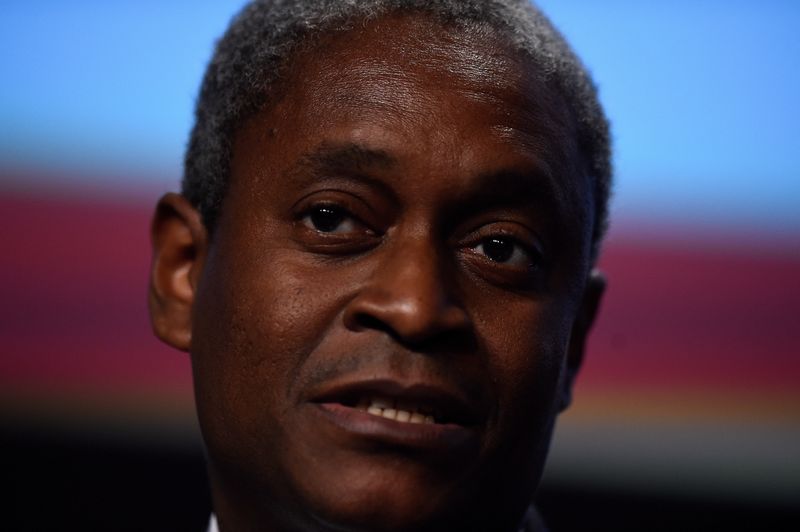By Howard Schneider
WASHINGTON (Reuters) - New data on Thursday is expected to show U.S. inflation still at multi-decade highs, but Federal Reserve officials are holding out hope that the peak may be near.
"There is some evidence we are on the cusp" of inflation that begins to ease perhaps by midyear, Atlanta Fed president Raphael Bostic said in an interview with CNBC on Wednesday.
In separate comments Cleveland Fed president Loretta Mester said she also expected inflation to ease this year as the Fed steadily tightens credit.
The headline consumer price index is expected to have increased more than 7% in January on an annualized basis, a level reminiscent of the inflation shocks of the 1970s and 1980s that has pushed the Fed to accelerate plans to raise borrowing costs and reduce its holdings of government bonds and mortgage-backed securities
But the month-to-month pace of change has been easing, a sign the economy may be working through supply-chain and other difficulties created by the pandemic.
Graphic: Peaking inflation? - https://graphics.reuters.com/USA-FED/INFLATION/klvykmjjwvg/chart.png
"What we have seen is inflation not get worse on a month-to-month level, and I am hopeful that will translate into a slow decline as we move through the spring and into summer," Bostic said. That "will give me some comfort that we are heading in the right direction" and perhaps allow the Fed to raise rates at a slower pace as the economy continues to recover, he said.
Graphic: Taking it in stride - https://graphics.reuters.com/USA-FED/INFLATION/lbvgnwmydpq/chart.png
There is broad agreement at the Fed to begin raising interest rates at the March 15-16 policy meeting. But there is no clarity about how much the Fed will have to do to counter inflation, or how likely it is that goods supply chains and the U.S. labor market will return on their own to something like the pre-pandemic normal of low inflation alongside low rates of joblessness.
Some analysts argue the Fed is already out of step with where the economy is heading. The unemployment rate is currently 4%, low by historic standards, and may be heading much lower amid record numbers of job openings, rising wages, and an economy that may surge over the year as the current pandemic wave recedes.
Some see the unemployment rate dipping to or below 3% https://www.reuters.com/business/us-road-1950s-style-unemployment-it-may-only-be-pit-stop-2022-02-07 this year, something not seen since the 1950s.
"The economy is blowing through stop signs," Ethan Harris, Bank of America (NYSE:BAC)'s head of global economics, said this week. Harris has been among the most aggressive forecasters in expecting the Fed will raise interest rates seven times this year, which would mean hikes at each of its remaining policy meetings in 2022.
"They are really not ready to capitulate and say we are late," in fighting inflation, he said. "I think they should."
A lockstep, meeting-by-meeting tightening cycle has not been seen since the early 2000s, at the end of former Fed chief Alan Greenspan's tenure.
But the pandemic-era economy has surprised more than once, and there are large competing forces at work - a decline of federal government spending, for example, that could slow consumption, and healthy household balance sheets that could sustain it.
Ian Shepherdson, chief economist at Pantheon Macroeconomics, said he expects a combination of rising inventories, eased global shipping conditions, and initial Fed rate increases will pull inflation down fast -- back to the Fed's 2% target sometime next year, with prices for keys goods like automobiles even falling later in 2022.
Rates will still need to rise, he said, but because the economy is improving, not because of a Fed "sprint" to battle inflation.
Graphic: Where's the panic? - https://graphics.reuters.com/USA-FED/INFLATION/gdvzynjakpw/chart.png
"This Fed will tread cautiously once they feel they have the trend inflation picture in hand. That should come by the middle of the year," Shepherdson said, when he anticipates car prices will be "in free fall," housing price appreciation will slow, and year-to-year price comparisons will work in the favor of a lower inflation reading.
FINANCIAL MARKETS, SUPPLY CHAINS
In financial markets the interest rates charged to households and companies already have risen since the Fed started slowing its bond purchases late last year and signaled rate hikes to come. A "shadow" federal funds rate maintained by the Atlanta Fed shows bond markets have produced the equivalent since then of a nearly 2-percentage-point increase. The cost to finance a home is rising.
There is some evidence of supply-chain improvement as well. Inventories across many goods sectors have been rebuilt, a buffer against the sort of shortages that jacked up prices for goods early in the pandemic.

Following the release of its latest earnings on Wednesday, executives at shipping giant A.P. Moller-Maersk said they anticipated a "normalization" in global shipping conditions in the second half of 2022. Port backlogs and container shortages have plagued companies throughout the pandemic as world manufacturers found it harder to reopen the global economy than it was to shut it down in response to the pandemic.
"Inflation has peaked," Moody's (NYSE:MCO) Analytics Chief Economist Mark Zandi said on Twitter (NYSE:TWTR). "As the pandemic continues to fade...so too will inflation. Global supply chains are ironing things out...And wage growth will moderate as workers get healthy again."